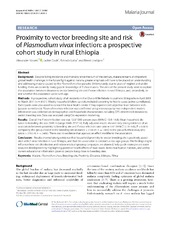| dc.contributor.author | Nissen, Alexander | en_US |
| dc.contributor.author | Cook, Jackie | en_US |
| dc.contributor.author | Loha, Eskindir | en_US |
| dc.contributor.author | Lindtjorn, Bernt | en_US |
| dc.date.accessioned | 2018-08-07T13:46:22Z | |
| dc.date.available | 2018-08-07T13:46:22Z | |
| dc.date.issued | 2017-09-19 | |
| dc.Published | Nissen A, Cook J, Loha E, Lindtjorn B. Proximity to vector breeding site and risk of Plasmodium vivax infection: a prospective cohort study in rural Ethiopia. Malaria Journal. 2017;16:380 | eng |
| dc.identifier.issn | 1475-2875 | |
| dc.identifier.uri | https://hdl.handle.net/1956/18028 | |
| dc.description.abstract | Background: Despite falling incidence and mortality since the turn of the century, malaria remains an important global health challenge. In the future fight against malaria, greater emphasis will have to be placed on understanding and addressing malaria caused by the Plasmodium vivax parasite. Unfortunately, due to years of neglect and underfunding, there are currently many gaps in knowledge of P. vivax malaria. The aims of the present study were to explore the association between distance to vector breeding site and P. vivax infection in rural Ethiopia, and, secondarily, to test whether this association varies with age. Methods: A prospective, cohort study of all residents in the Chano Mille Kebele in southern Ethiopia from April 2009 to March 2011 (n = 8121). Weekly household follow up visits included screening for febrile cases (active surveillance). Participants were also asked to contact the local health centre if they experienced subjective fever between visits (passive surveillance). Plasmodium vivax infection was confirmed using microscopy by two independent readers. Information was collected on demographics and household characteristics including GPS-determined distance to vector breeding site. Data was analysed using Cox regression modelling. Results: Overall the P. vivax infection rate was 12.3/1000 person-years (95% CI 10.5–14.5). Mean household distance to breeding site was 2449 m (range 1646–3717 m). Fully adjusted results showed very strong evidence of an association between proximity to breeding site and P. vivax infection: rate ratio = 3.47 (95% CI 2.15–5.60; P < 0.001) comparing the group closest to the breeding site (distance < 2100 m; n = 1383) to the group furthest away (distance > 2700 m; n = 2460). There was no evidence that age was an effect modifier in the association. Conclusion: Results showed strong evidence that household proximity to vector breeding site is positively associated with P. vivax infection in rural Ethiopia, and that this association is constant across age groups. The findings might influence how net-distribution and indoor residual spraying campaigns are planned, help guide strategies on water resource development by highlighting potential health effects of man-made dams near human habitats, and add to current educational information given to people living close to breeding sites. | en_US |
| dc.language.iso | eng | eng |
| dc.publisher | BioMed Central | eng |
| dc.rights | Attribution CC BY | eng |
| dc.rights.uri | http://creativecommons.org/licenses/by/4.0 | eng |
| dc.subject | Malaria | eng |
| dc.subject | Plasmodium vivax | eng |
| dc.subject | Breeding site | eng |
| dc.subject | Proximity | eng |
| dc.subject | Distance | eng |
| dc.subject | Ethiopia | eng |
| dc.subject | Africa | eng |
| dc.title | Proximity to vector breeding site and risk of Plasmodium vivax infection: a prospective cohort study in rural Ethiopia | en_US |
| dc.type | Peer reviewed | |
| dc.type | Journal article | |
| dc.date.updated | 2018-03-06T13:57:20Z | |
| dc.description.version | publishedVersion | en_US |
| dc.rights.holder | Copyright 2017 The Author(s) | |
| dc.identifier.doi | https://doi.org/10.1186/s12936-017-2031-5 | |
| dc.identifier.cristin | 1526832 | |
| dc.source.journal | Malaria Journal | |
| dc.relation.project | Norges forskningsråd: 220554 | |

